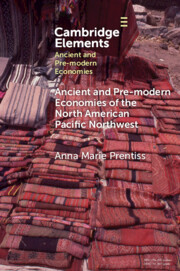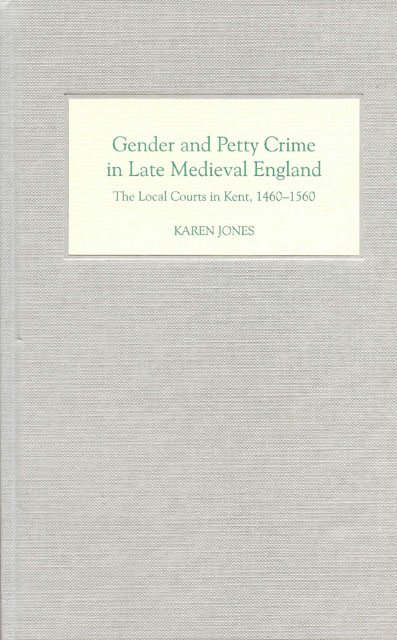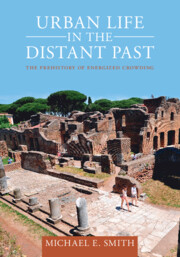Refine search
Actions for selected content:
23990 results in Ancient history
Figures
-
- Book:
- Urban Life in the Distant Past
- Published online:
- 15 March 2023
- Print publication:
- 30 March 2023, pp x-xii
-
- Chapter
- Export citation
Two - The Prehistory of Energized Crowding
-
- Book:
- Urban Life in the Distant Past
- Published online:
- 15 March 2023
- Print publication:
- 30 March 2023, pp 34-58
-
- Chapter
- Export citation
Six - Top-Down Institutions and the Scale of Urban Life
-
- Book:
- Urban Life in the Distant Past
- Published online:
- 15 March 2023
- Print publication:
- 30 March 2023, pp 171-195
-
- Chapter
- Export citation
Appendix A - Sources of Population and Commercialization Data for the Case Studies
-
- Book:
- Urban Life in the Distant Past
- Published online:
- 15 March 2023
- Print publication:
- 30 March 2023, pp 251-257
-
- Chapter
- Export citation
Four - States, Cities, and Power
-
- Book:
- Urban Life in the Distant Past
- Published online:
- 15 March 2023
- Print publication:
- 30 March 2023, pp 99-138
-
- Chapter
- Export citation
Tables
-
- Book:
- Urban Life in the Distant Past
- Published online:
- 15 March 2023
- Print publication:
- 30 March 2023, pp xiii-xiii
-
- Chapter
- Export citation
References
-
- Book:
- Urban Life in the Distant Past
- Published online:
- 15 March 2023
- Print publication:
- 30 March 2023, pp 260-307
-
- Chapter
- Export citation
Index
-
- Book:
- Urban Life in the Distant Past
- Published online:
- 15 March 2023
- Print publication:
- 30 March 2023, pp 308-318
-
- Chapter
- Export citation
Seven - Generative Forces and Urban Life
-
- Book:
- Urban Life in the Distant Past
- Published online:
- 15 March 2023
- Print publication:
- 30 March 2023, pp 196-225
-
- Chapter
- Export citation
Appendices
-
- Book:
- Urban Life in the Distant Past
- Published online:
- 15 March 2023
- Print publication:
- 30 March 2023, pp 251-259
-
- Chapter
- Export citation
Five - Markets, Crafts, and Urban Life
-
- Book:
- Urban Life in the Distant Past
- Published online:
- 15 March 2023
- Print publication:
- 30 March 2023, pp 139-170
-
- Chapter
- Export citation
Case Studies
-
- Book:
- Urban Life in the Distant Past
- Published online:
- 15 March 2023
- Print publication:
- 30 March 2023, pp xiv-xiv
-
- Chapter
- Export citation
One - Premodern Cities and the Wide Urban World
-
- Book:
- Urban Life in the Distant Past
- Published online:
- 15 March 2023
- Print publication:
- 30 March 2023, pp 1-33
-
- Chapter
- Export citation
Three - The Size of Cities and Settlements
-
- Book:
- Urban Life in the Distant Past
- Published online:
- 15 March 2023
- Print publication:
- 30 March 2023, pp 59-98
-
- Chapter
- Export citation

Ancient and Pre-modern Economies of the North American Pacific Northwest
-
- Published online:
- 29 March 2023
- Print publication:
- 27 April 2023
-
- Element
- Export citation

Gender and Petty Crime in Late Medieval England
- The Local Courts in Kent, 1460-1560
-
- Published by:
- Boydell & Brewer
- Published online:
- 23 March 2023
- Print publication:
- 20 July 2006

Fourteenth Century England III
-
- Published by:
- Boydell & Brewer
- Published online:
- 21 March 2023
- Print publication:
- 25 March 2004

North-East England, 1569-1625
- Governance, Culture and Identity
-
- Published by:
- Boydell & Brewer
- Published online:
- 18 March 2023
- Print publication:
- 17 August 2006

A Companion to the Anglo-Norman World
-
- Published by:
- Boydell & Brewer
- Published online:
- 17 March 2023
- Print publication:
- 01 January 2002

Urban Life in the Distant Past
- The Prehistory of Energized Crowding
-
- Published online:
- 15 March 2023
- Print publication:
- 30 March 2023
